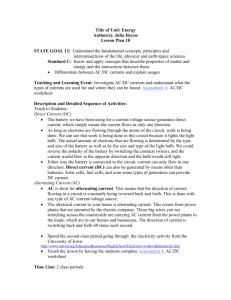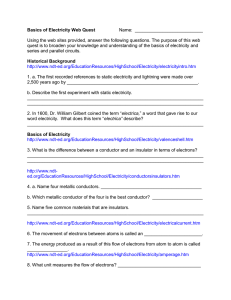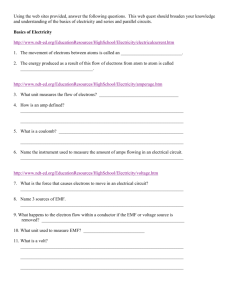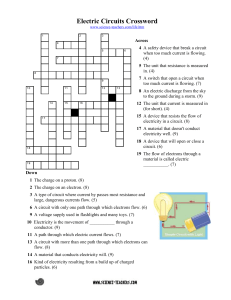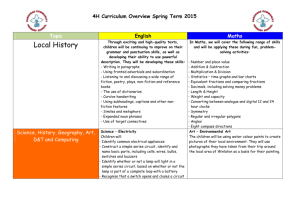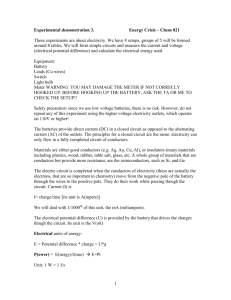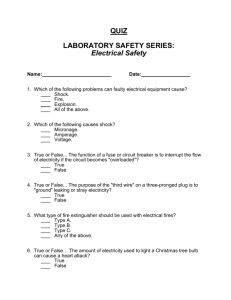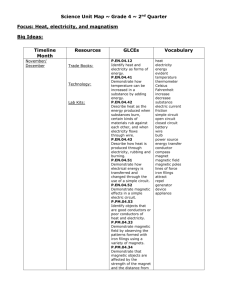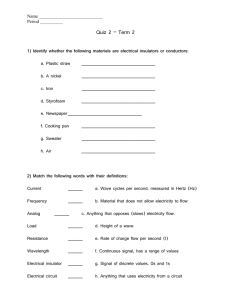Science Scavenger Hunt
advertisement
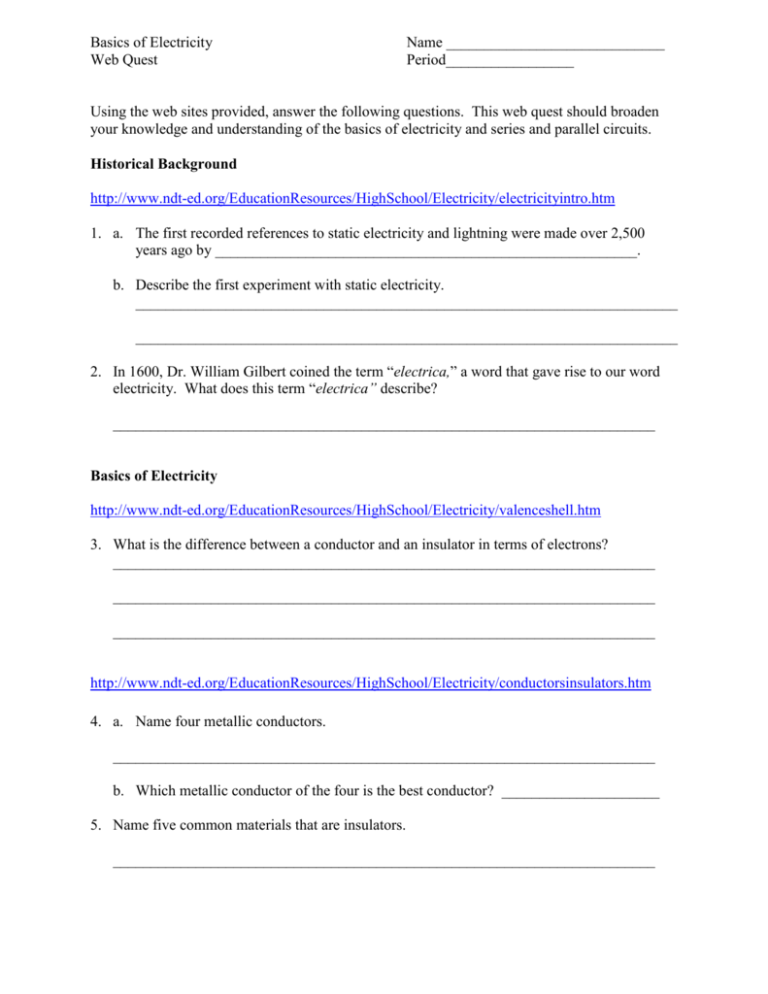
Basics of Electricity Web Quest Name _____________________________ Period_________________ Using the web sites provided, answer the following questions. This web quest should broaden your knowledge and understanding of the basics of electricity and series and parallel circuits. Historical Background http://www.ndt-ed.org/EducationResources/HighSchool/Electricity/electricityintro.htm 1. a. The first recorded references to static electricity and lightning were made over 2,500 years ago by ________________________________________________________. b. Describe the first experiment with static electricity. ________________________________________________________________________ ________________________________________________________________________ 2. In 1600, Dr. William Gilbert coined the term “electrica,” a word that gave rise to our word electricity. What does this term “electrica” describe? ________________________________________________________________________ Basics of Electricity http://www.ndt-ed.org/EducationResources/HighSchool/Electricity/valenceshell.htm 3. What is the difference between a conductor and an insulator in terms of electrons? ________________________________________________________________________ ________________________________________________________________________ ________________________________________________________________________ http://www.ndt-ed.org/EducationResources/HighSchool/Electricity/conductorsinsulators.htm 4. a. Name four metallic conductors. ________________________________________________________________________ b. Which metallic conductor of the four is the best conductor? _____________________ 5. Name five common materials that are insulators. ________________________________________________________________________ http://www.ndt-ed.org/EducationResources/HighSchool/Electricity/electricalcurrent.htm 6. The movement of electrons between atoms is called a ___________________________. 7. The energy produced as a result of this flow of electrons from atom to atom is called ________________________________. http://www.ndt-ed.org/EducationResources/HighSchool/Electricity/amperage.htm 8. What unit measures the flow of electrons? ___________________________________ 9. How is an amp defined? ________________________________________________________________________ ________________________________________________________________________ 10. What is a coulomb? _______________________________________________________ ________________________________________________________________________ 11. Name the instrument used to measure the amount of amps flowing in an electrical circuit. ________________________________________________________________________ http://www.ndt-ed.org/EducationResources/HighSchool/Electricity/voltage.htm 12. What is the force that causes electrons to move in an electrical circuit? ________________________________________________________________________ 13. Name 3 sources of EMF. ________________________________________________________________________ 14. What happens to the electron flow within a conductor if the EMF or voltage source is removed? _______________________________________________________________ 15. What unit is used to measure EMF? ___________________________ 16. What is a volt? ________________________________________________________________________ ________________________________________________________________________ ________________________________________________________________________ http://www.ndt-ed.org/EducationResources/HighSchool/Electricity/resistance.htm 17. What is resistance? ________________________________________________________________________ ________________________________________________________________________ 18. In what units is resistance measured? _____________________________ 19. Define the term: ohm. ________________________________________________________________________ ________________________________________________________________________ 20. State one example when resistance is desirable. ________________________________________________________________________ ________________________________________________________________________ 21. State one example when resistance is undesirable. ________________________________________________________________________ ________________________________________________________________________ 22. What components are placed in an electrical circuit to control the amount of resistance in circuit? _____________________________________ http://www.ndt-ed.org/EducationResources/HighSchool/Electricity/ohmslaw.htm 23. In 1827, George Ohm developed a mathematical relationship between voltage, current, and resistance called ___________________________________________. 24. a. State Ohm’s Law in a mathematical equation. __________________________________ b. What do the following variables represent? I = ____________________________ V = ____________________________ R = ___________________________ V I R 25. Using the equation, I = V / R, describe the following: a. If the voltage is increased what will happen to the current? _______________________ b. If the resistance is increased what will happen to the current? _____________________ 26. Using the second equation, V = I • R, describe the following: a. If either the current or the resistance is increased in the circuit, what will happen to the voltage? __________________________ 27. Using the third equation, R = V / I, describe the following: a. If the voltage is increased what will happen to the resistance? _____________________ b. If the current is increased what will happen to the resistance? ______________________ 28. What is the symbol of an ohm? ___________________ http://www.ndt-ed.org/EducationResources/HighSchool/Electricity/seriesparallelcircuits.htm 29. How is a circuit formed? ________________________________________________________________________ ________________________________________________________________________ ________________________________________________________________________ 30. Explain the relationship of potential and kinetic energy to electricity. ________________________________________________________________________ ________________________________________________________________________ ________________________________________________________________________ http://www.ndt-ed.org/EducationResources/HighSchool/Electricity/circuitdiagrams.htm Below is a circuit diagram, list what each part of the diagram represents. Answers are placed on the spaces below. 31. = __________________________ 32. = __________________________ 33. = 34. = ___________________________ 35. = ___________________________ ___________________________ 36. Describe the battery’s positive terminal. ______________________________________ 37. Describe the battery’s negative terminal. ______________________________________ Other useful symbols used in electrical circuit diagrams: 38. 39. = _______________________________ A capacitor is used to store electrical charge. An example would be a timer. =________________________________ http://www.ndt-ed.org/EducationResources/HighSchool/Electricity/seriescircuit.htm 40. Build the series circuit at this web site. 41. Describe a series circuit. ________________________________________________________________________ ________________________________________________________________________ ________________________________________________________________________ 42. What is a load in a circuit? ________________________________________________________________________ ________________________________________________________________________ 43. What is a short circuit? ________________________________________________________________________ ________________________________________________________________________ ________________________________________________________________________ 44. What is used in an electrical circuit to prevent a short circuit? ________________________________________________________________________ 45. Build the series circuit with resistors at this web site. http://www.ndt-ed.org/EducationResources/HighSchool/Electricity/parallelcircuit.htm 46. Build the parallel circuit at this web site. 47. Describe a parallel circuit. ________________________________________________________________________ ________________________________________________________________________ 48. Build the parallel circuit with a voltmeter at this web site. 49. How is the ammeter always placed in a circuit? __________________________________ 50. How is the voltmeter always placed in a circuit? _________________________________ http://www.ndt-ed.org/EducationResources/HighSchool/Electricity/seriesparallel.htm 51. Build the series / parallel circuit at this web site. 52. List the components that are connected in series from the circuit you just constructed. ________________________________________________________________________ ________________________________________________________________________ ________________________________________________________________________ 53. List the components that are in parallel from the circuit you just constructed. ________________________________________________________________________ ________________________________________________________________________ http://www.ndt-ed.org/EducationResources/HighSchool/Electricity/directcurrent.htm 54. What does DC mean in terms of electrical current? ________________________________________________________________________ ________________________________________________________________________ 55. What do we use every day in our electronic devices that is a good source of direct current? ________________________________________________________________________ http://www.ndt-ed.org/EducationResources/HighSchool/Electricity/alternatingcurrent.htm 56. What does AC mean in terms of electrical current? ________________________________________________________________________ ________________________________________________________________________ 57. How often is the current alternating directions? ________________________________________________________________________ ________________________________________________________________________ http://www.ndt-ed.org/EducationResources/HighSchool/Electricity/electromagnetism.htm 58. Describe how a magnetic field is created. _______________________________________________________________________ 59. The production of a magnetic field by current flowing in a conductor is called ___________. 60. What determines the magnetic polarity of an electromagnet? ___________________________________________________________________________
